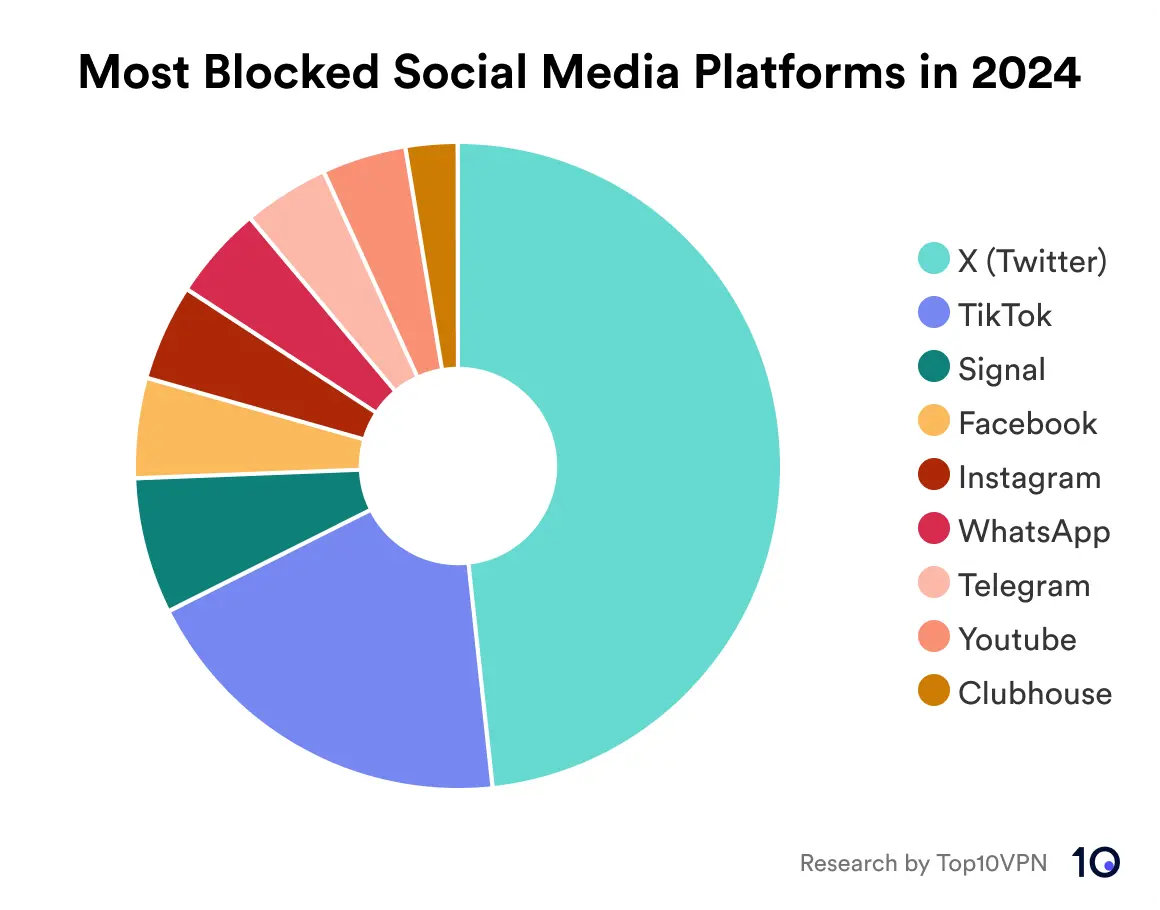Government Internet Shutdowns Cost $7.69 Billion in 2024
Our annual report analyzes every major intentional internet shutdown in 2024 and reveals that they cost the world economy $7.69 billion.

First published Jan 2, 2020. Last updated to publish the full 2024 annual report on the cost of internet shutdowns.
Internet Shutdowns: Economic Impact 2024
- $7.69 billion: economic cost of internet shutdowns in 2024
- 167 major self-imposed internet outages took place in 28 countries – the highest number of countries in a single year, to date.
- 88,788 hours of government internet disruptions, a 12% increase on 2023 and highest to date. This included:
- Internet blackouts: 49,101 hours
- Social media blocks: 39,687 hours
- 648.4 million people affected by deliberate internet outages in 2024
- X (Twitter) was the most blocked social media platform, suffering 20,322 hours of deliberate disruption, followed by TikTok (8,115 hrs) and Signal (2,880 hrs).
- Pakistan: the single most affected nation ($1.62 billion), followed by Myanmar ($1.58 billion) and Sudan ($1.12 billion).
- Iraq: the nation with most internet shutdowns (61) for second successive year, all prompted by school exams.
- Myanmar and Azerbaijan: the longest shutdowns imposed this year, totaling over 8,784 hours each in 2024.
- Human rights impact: A third of government internet outages were associated with additional human rights abuses in 2024, most frequently restrictions on freedom of assembly.
What is the Cost of Internet Shutdowns Report?
This Global Cost of Internet Shutdowns report calculates the total economic impact of every major deliberate internet outage and social media shutdown around the world in 2024.
This kind of deliberate outage is internet censorship in its most extreme form. Not only do they infringe on citizens’ digital rights but they are also catastrophic acts of national economic self-sabotage.
Government internet outages in 28 countries lasting almost 89,000 hours cost the global economy $7.69 billion in 2024.
While the cost of internet shutdowns may have dropped by 15.8% in 2024 compared to last year, there were more hours of deliberate internet disruption than ever before.
The duration of internet shutdowns was up 12% in 2024 compared to 2023. This was the highest number of hours in a single year to date.
There were also almost double the hours of internet blackouts (92.3%) compared to last year, but 26.1% fewer hours of social media shutdowns.
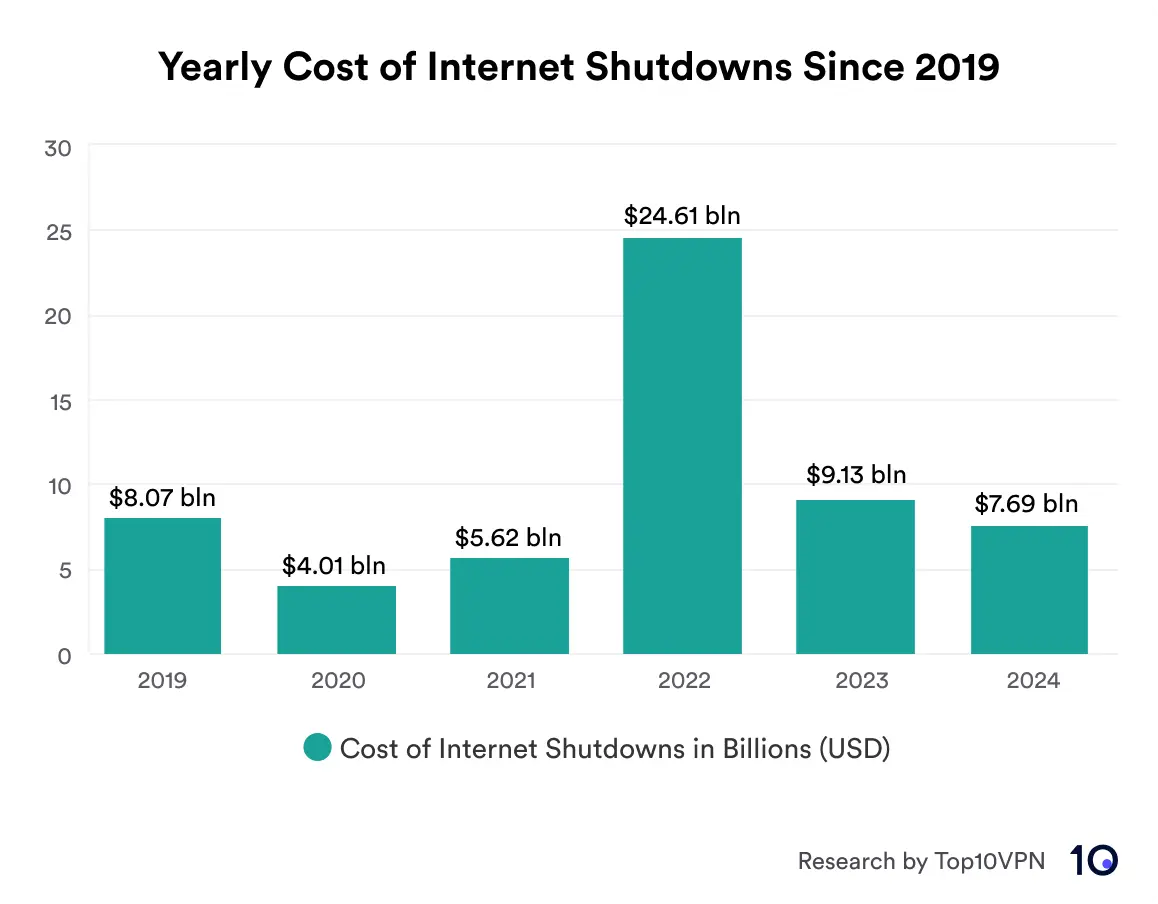
Chart showing the yearly cost of internet shutdowns since 2019.
How Do We Calculate The Cost of Internet Shutdowns?
We constantly monitor for national and region-wide internet outages and social media shutdowns imposed by governments around the world.
After determining the duration and extent of the restrictions, we calculate their economic impact using the COST tool.
This tool was developed by internet monitoring NGO Netblocks. It is based on indicators from the World Bank, ITU, Eurostat and US Census.
WHAT’S INCLUDED IN OUR CALCULATIONS:
- Internet blackouts: internet access is completely cut off by the government. This extreme measure cannot be directly circumvented.
- Social media shutdowns: access to popular social media, such as Facebook, WhatsApp, TikTok or X is blocked. This can typically be circumvented by using a Virtual Private Network (VPN).
- Severe throttling: internet speeds have been reduced to 2G, which permits the use of SMS and voice calls only. This is an internet blackout in all but name.
This year’s report continues with the approach, first introduced last year, of excluding social media blocks once they are over 365 days long.
After this point, we consider it to be permanent censorship and assume the economic impact to have lessened as people are likely to have switched platforms by then.
The social media bans in Russia, for example, that drove the record-breaking spike in costs to the world economy in 2022 continue to be excluded from our reports despite being ongoing.
Note that we have included the current restrictions on X (Twitter) in Myanmar.
Although these were first imposed in 2021, access to X had largely been restored by the start of this year.
Since late February 2024, however, authorities in Myanmar once again started blocking access to X. As this was a new restriction, we treated it as a new shutdown and included it in our report.
This is also the second year we have included blocks of newer social media platforms, such as TikTok and Telegram. This means we are now once again more easily able to make year-over-year comparisons.
Cost of Internet Shutdowns 2019-2023
- 2023: 196 internet shutdowns in 25 countries lasting 79,238 hours cost $9.01 billion. Russia was the most affected nation with a cost of $4.02 billion.
- 2022: 114 internet shutdowns in 23 countries lasting 50,095 hours cost $24.61 billion. Russia was the most affected nation with a cost of $21.59 billion.
- 2021: 50 internet shutdowns in 21 countries lasting 30,179 hours cost $5.45 billion. Myanmar inflicted the worst economic damage on itself via internet outages ($2.8 billion).
- 2020: 93 internet shutdowns in 21 countries lasting 27,165 hours cost $4.01 billion. India imposed the most costly internet outages overall ($2.8 billion).
- 2019: 134 internet shutdowns in 22 countries lasting 19,207 hours cost $8.07 billion. Iraq’s internet outages were most costly ($2.3 billion).
Why Do We Track The Cost of Internet Shutdowns?
We passionately oppose internet censorship and the restriction of internet access by governments as a form of social control.
Our goal remains to keep public attention focused on the damage caused by internet shutdowns.
This damage is both direct, in terms of the economic and human cost, and indirect, in that it forces people to use unsafe VPNs to try to bypass the unfair restrictions imposed upon them.
Internet Shutdowns 2024: Cost by Country
The following data table shows all countries that have experienced a major internet shutdown in 2024. The table is ordered from greatest to least economic impact, measured in USD.
The data table also indicates the nature of any additional human rights abuses perpetrated during each internet shutdown. A cross indicates that the human right specified was violated during the period around the internet outage. Scroll or swipe to see all the columns.
For data on individual internet shutdowns, see the Cost of Internet Shutdowns 2024 Data Sheet.
Internet Shutdowns 2024: Cost by Region
This data table shows the total economic cost of all major deliberate internet outages in 2024, broken down by the global region. It is ordered by economic impact, measured in USD. Russia is included as part of Europe, and Turkey, Asia.
Asia was by far the most-affected region, thanks to the particularly impactful internet restrictions in Pakistan, Myanmar, Bangladesh and India. These nations were four of the six most-affected countries in 2024.
Both Asia and Sub-Saharan Africa had around ten times as many hours or more of internet shutdowns as the next most-affected regions.
The bar chart below shows the economic impact of all major internet shutdowns in 2024 on each of the global regions where the disruptions occurred, broken down by context, i.e. the reason why the internet outage was implemented.
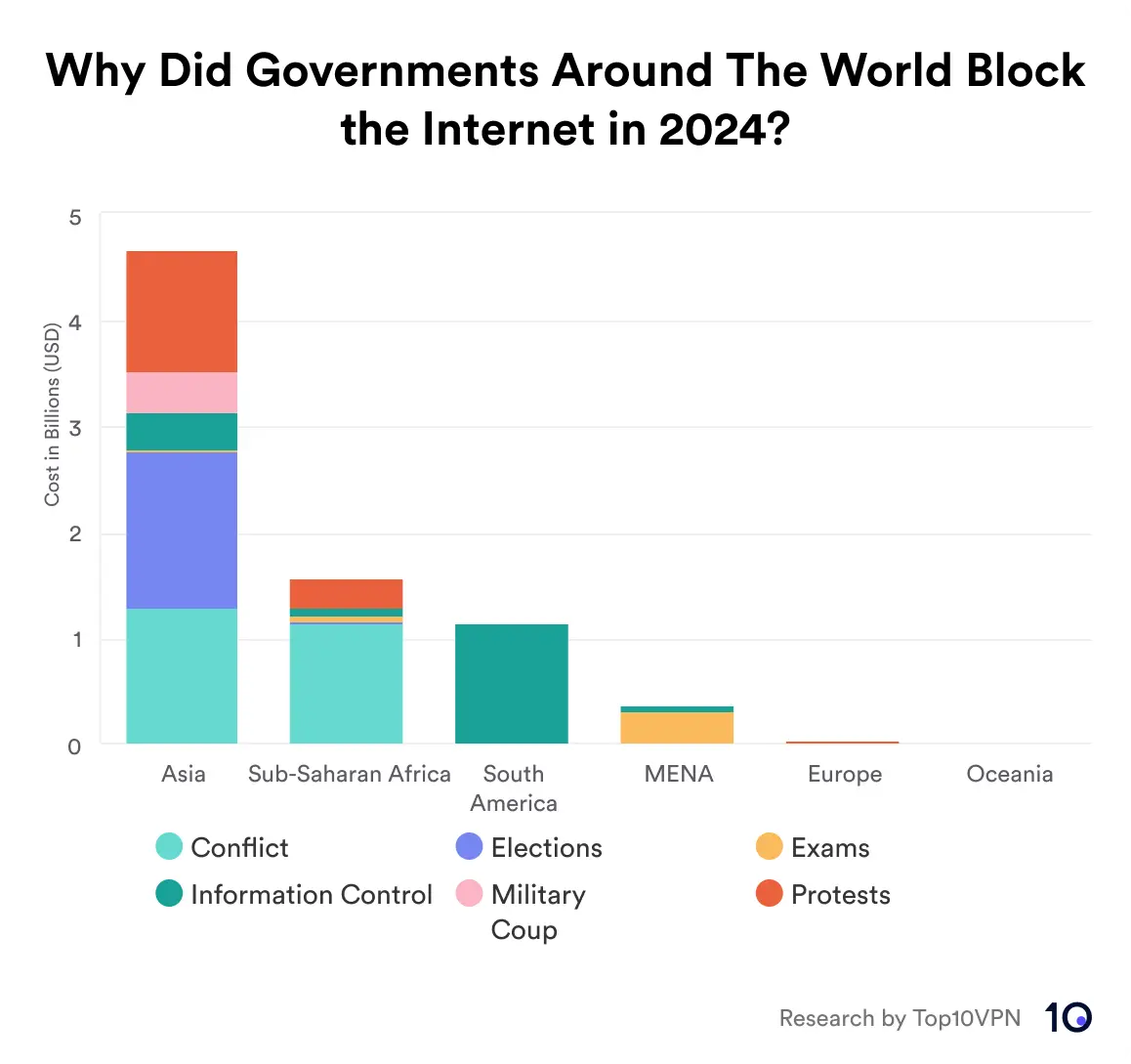
Bar chart showing reasons why governments blocked internet access in 2024, by region.
As you can see civil conflict was a major cause of government internet disruption in 2024, with the ongoing situations in Sudan and Myanmar having the greatest economic impact.
Internet Shutdowns 2024: Cost by Context
This data table shows the total economic cost of all major internet shutdowns in 2024 grouped by context, i.e. what prompted local authorities to cut internet access. The table is ordered from greatest to least economic impact, measured in USD.
The table also indicates the number of incidents in each category and the total duration of the internet outages, in hours.
This chart shows the split of the economic cost of all major government internet outages in 2024 by context, i.e. what prompted local authorities to cut internet access.
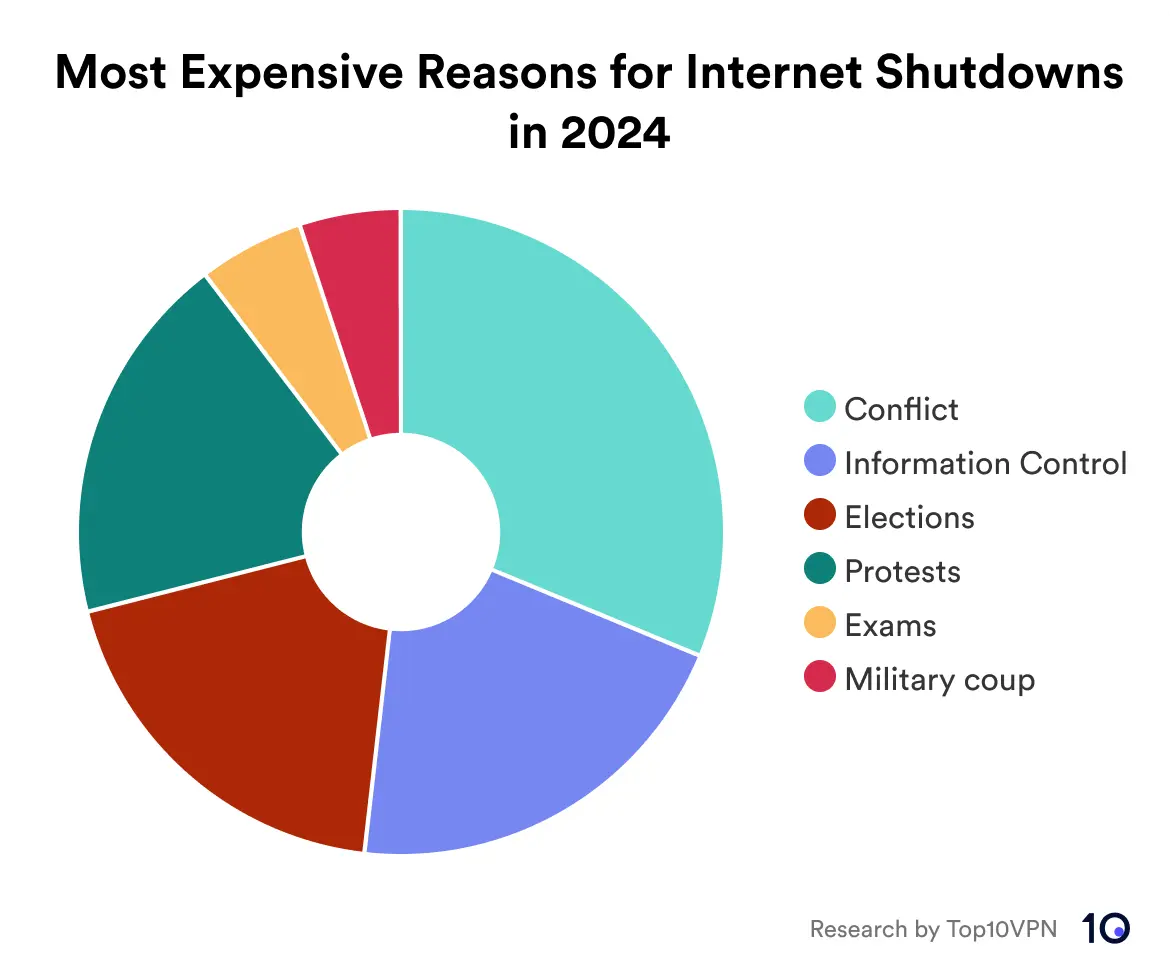
Chart showing the reasons for internet shutdowns in 2024 with the most economic impact.
This next chart shows the split of reasons for all major government internet outages in 2024 by frequency.
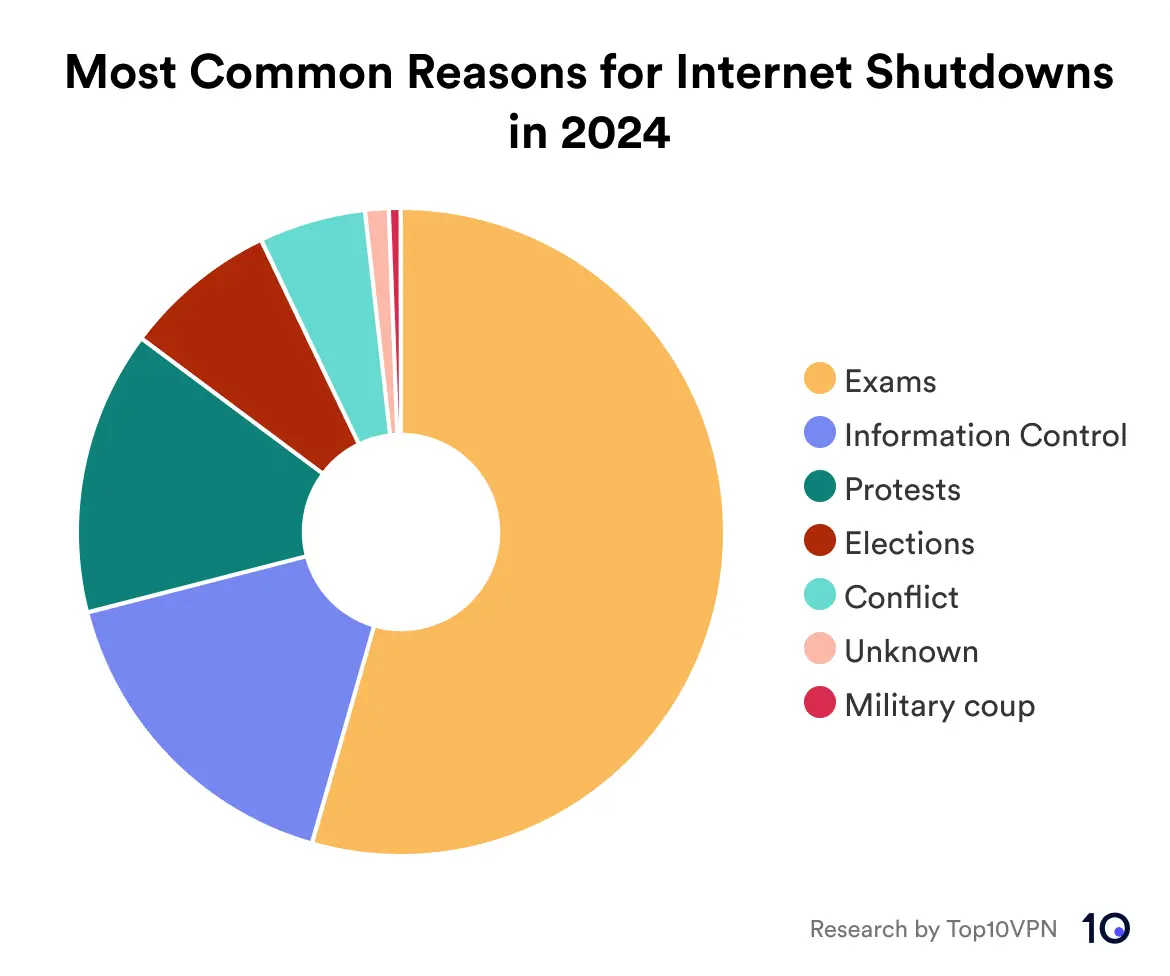
Chart showing the most common reasons for internet shutdowns in 2024.
As the charts show, while more than half of internet shutdown incidents were due to exams, their economic impact was much more limited. These shutdowns may have been numerous but they were typically just a couple of hours long.
Nevertheless, this approach to preventing cheating on exams still cost the world economy over $400 million and disrupted the lives of millions of innocent people.
At the other end of the scale, the internet outages imposed due to conflict were few but very drawn out, causing severe additional harm in countries whose people were already suffering.
2024 was the third year in a row where this was the prime cause for the internet shutdowns with biggest economic impact.
DETAILS OF INDIVIDUAL INTERNET SHUTDOWNS:
Download the Cost of Internet Shutdowns 2024 Data Sheet for details of each individual shutdown.
For each disruption, there’s dates, any local regions affected, a cost breakdown, the type of outage it was, which platforms were blocked, how many people were affected, and the reason for the shutdown.
Note that while we state that there were 167 shutdowns in 2024, there are more entries than that. This is because we often have to break down a disruption into multiple parts in order to properly calculate its cost.
How Do Governments Shut Down The Internet?
Government internet outages typically take the form of total internet blackouts or social media blocks. Another censorship tactic is internet throttling, where internet speeds are restricted so severely that anything beyond simple text-based communication becomes impossible, such as live-streaming video of protests or human rights abuses.
Internet Service Providers (ISPs) use a number of methods to implement restrictions following government orders to do so. Some of the most common are below.
Network Shutdown
The most crude method of blocking access to the internet is when governments force ISPs and mobile carriers to literally power down critical circuits that make up the country’s telecommunications network.
Governments that have complete control over their country’s network may also install an “internet kill-switch”. The UN has condemned the use of such single shut-off mechanisms.
Border Gateway Protocol (BGP) Manipulation
BGP is the protocol that manages the global routing system of the internet, which allows packets of data to travel from their source to their destination. It works via requiring every network node (known as an Autonomous System or AS) making up the global internet to constantly advertise which IP addresses it gives access to.
These announcements flash back and forth across the whole network, marking the route between any two points on that network, each of which is a cluster of IP addresses. This protocol is what makes it possible to access a website or app hosted in another location.
By manipulating the contents of these announcements, or BGP routing tables, an ISP can make the Internet Protocol (IP) addresses of any number of its customers “disappear” from the internet, effectively cutting off access for those people. This is more precise than a full network shutdown and allows for exceptions to be made, such as for government officials.
IP Address Blocking
Websites and apps rely on web servers to host their content, each of which has its own IP address. This unique numerical address allows devices to find and communicate with each other.
ISPs can create lists of IP addresses that correspond with services they want to block and then block all internet traffic to or from those IP addresses.
As multiple websites and services can be hosted on a single IP address, this method of internet censorship often leads to unintentionally blocking more than was intended.
Domain Name System (DNS) Filtering
DNS filtering works in a similar way to IP blocking but is more precise as it targets the domain name rather than an IP address.
Information associated with domain names, such as top10vpn.com, are stored in a database distributed across multiple DNS Servers. Browsers rely on intermediate services, called DNS resolvers, to perform DNS lookups for specific domains against these databases, and retrieve the relevant destination IP address of the server, which then lets the browser communicate with the server that holds the desired URL.
ISPs can program these DNS resolvers to return incorrect information for particular DNS lookups, such as twitter.com not existing. When this happens, users are met with an error page instead of the website or app loading as normal.
Deep Packet Inspection (DPI)
DPI examines the full contents of the data packets making up internet traffic on a network to allow for blocking of specific content or applications. DPI relies on devices between the end user and the rest of the internet, known as middleboxes and which form a key role in internet censorship in places like China. Manufacturers include companies like Huawei and Allot.
DPI is also very effective at throttling speeds for specific types of traffic, such as video or Voice Over Internet Protocol (VOIP).
As a result, VPNs that actually work in China have to use technology like traffic obfuscation to bypass DPI.
Protocol Blocking
Targeting specific protocols, such as TCP/IP port number is another method for blocking or throttling certain apps associated with known TCP/IP ports.
Governments can use this method to target instant messaging services or email for example to prevent citizens from communicating.
How to Bypass An Internet Shutdown
It’s not possible to bypass a full internet blackout and actually get online in any normal way, however there are still countermeasures available to avoid becoming completely isolated.
Fortunately social media shutdowns and other online content blocks are far more common forms of internet censorship and can be circumvented using the right tools.
EXPERT TIP: In some countries, some of these tools might be outlawed, so it’s important to weigh up any legal risk before proceeding.
VPNs
A VPN works by encrypting a user’s internet connection and changing their IP address. Unless an ISP is able to block every single IP address used by a VPN service or identify VPN traffic and block it, then a VPN will allow a user to easily access sites and apps blocked using IP and DNS filtering.
Governments will often try to block VPN downloads during a social media shutdown. It’s therefore important for anyone living under such regimes to be prepared and download a trustworthy and reliable VPN that works in their country before an internet outage takes place.
Some internet shutdowns will also incorporate protocol blocking to prevent VPNs being used to circumvent them. VPN services that use obfuscation techniques, however, will still work.
Tor
Tor is a free, open-source system designed to enable anonymous communication on the web. The name comes from the original project name: “The Onion Router”. Like a VPN, Tor encrypts your activity and hides your IP address, enabling users to access blocked online services.
For a dissident in a high-censorship regime, the complete anonymity provided by Tor makes it worth the trade-off in terms of speed and usability. For everyone else, a VPN is the better option.
Signal
Facebook Messenger and WhatsApp are frequently affected when governments block social media, making it difficult for loved ones to communicate in countries where these platforms might be the only reliable method of personal communication.
Make sure that you and anyone you might need to contact during an internet outage has installed Signal, which has the added benefit of being more secure than other messaging platforms.
Bluetooth Mesh Networks
Protestors can turn to apps like Bridgefy and FireChat to communicate when governments cut off internet access completely during civil unrest. The apps create local peer-to-peer mesh networks that rely on Bluetooth rather than the internet to exchange messages and data.
Roaming SIM card
If a government internet shutdown appears likely and getting online is critical, it’s worth preparing ahead of time and acquiring international roaming SIM cards from a neighboring country. Foreign mobile carriers will not be affected by any outage and will allow you to get online, albeit at potentially significantly extra cost.
Sneakernet
A sneakernet refers to using human movement to physically deliver information between people affected by an internet outage, or even to smuggle data about what’s happening out of the country. Download and store important information on thumb drives or external hard drives, ideally encrypted using software such as Veracrypt, and give it to someone traveling to the location of your intended recipient.
Cost of Internet Shutdowns 2023 Report
The Cost of Internet Shutdowns 2023 annual report was published on Jan 2 2024. This analysis of every major deliberate internet outage imposed by national governments in 2023 calculated their economic impact to be over $9.13 billion.
How Much Did Internet Shutdowns Cost Us in 2023?
- $9.13 billion: economic cost of internet shutdowns globally in 2023
- 196 major internet outages took place in 25 countries in 2023
- 79,238 hours: total duration of major internet shutdowns around the world, up 58% from the previous year
- 747 million people affected in 2023, up 5% year-on-year
- Russia: had the most costly internet shutdowns, suffering a total loss of $4.02 billion
Read the full 2023 Cost of Internet Shutdowns Report
Cost of Internet Shutdowns 2022 Report
The Cost of Internet Shutdowns 2022 annual report was published on Jan 3 2023. This analysis of every major deliberate internet outage imposed by national governments in 2022 calculated their economic impact to be over $24.61 billion.
How Much Did Internet Shutdowns Cost Us in 2022?
- $24.61 billion: economic cost of internet shutdowns globally in 2022, up by 337% from 2021
- 114 major internet outages took place in 23 countries in 2022
- 50,095 hours: total duration of major internet shutdowns around the world, up 45% from the previous year
- 710 million people affected in 2022, up 41% year-on-year
- Russia: had the most costly internet shutdowns, suffering a total loss of $21.59 billion
Read the full 2022 Cost of Internet Shutdowns Report
Cost of Internet Shutdowns 2021 Report
The Cost of Internet Shutdowns 2021 annual report was published on Jan 4 2022. This analysis of every major deliberate internet outage imposed by national governments in 2021 calculated their economic impact to be over $5.6 billion.
How Much Did Internet Shutdowns Cost Us in 2021?
- $5.62 billion: economic cost of internet shutdowns globally in 2021, up by 40% from 2020
- 51 major internet outages took place in 22 countries in 2021
- 34,595 hours: total duration of major internet shutdowns around the world, up 11% from the previous year
- 504 million people affected in 2021, up 88% year-on-year
- Myanmar: had the most costly internet shutdowns, suffering a total loss of $2.8 billion
Read the full 2021 Cost of Internet Shutdowns Report
Cost of Internet Shutdowns 2020 Report
The Cost of Internet Shutdowns 2020 annual report was published on Jan 4 2021. This analysis of every major government internet shutdown in 2020 revealed their economic impact on a world economy to be in excess of $4 billion.
How Much Did Internet Shutdowns Cost Us in 2020?
- $4.01 billion: economic cost of internet shutdowns globally in 2020, down by 50% from 2019
- 93 major internet outages took place in 21 countries in 2020
- 27,165 hours: total duration of major internet shutdowns around the world, up 49% from the previous year
- 268 million people affected in 2020, up 3% year-on-year
- India: had the most costly internet shutdowns, suffering a total loss of $2.8 billion
Read the full 2020 Cost of Internet Shutdowns Report
Cost of Internet Shutdowns 2019 Report
The 2019 Cost of Internet Shutdowns annual report was published on Jan 7 2020. The report analyzed for the first time every major intentional internet outage over the course of a year and calculated the global cost of shutdowns in 2019 to have been over $8 billion.
How Much Did Internet Shutdowns Cost Us in 2019?
- $8.07 billion: economic cost of internet shutdowns globally in 2019 – an increase of 235% since 2015/16
- 134 major internet shutdowns took place in 22 countries during 2019
- 19,207 hours: total duration of major government internet outages around the world
- Iraq: suffered the most economically from internet blackouts, followed by Sudan and India
- WhatsApp: most-blocked platform, experiencing 7,044 total hours of government internet censorship
Read the full 2019 Cost of Internet Shutdowns Report
Internet Shutdowns Research Methodology
We review every documented government internet outage and social media shutdown globally in a given year.
We include deliberate national internet blackouts along with regional disruptions that are on a sufficient scale to be economically significant.
The nature, duration and severity of each internet outage are sourced from Netblocks real-time graphic data and reports, IODA, the SFLC.IN Internet Shutdown Tracker, and OONI’s internet censorship measurement tools.
The economic cost of each internet shutdown is calculated using the Netblocks Cost of Shutdown Tool, which is based on the Brookings Institution method, with CIPESA’s specialized model used for sub-Saharan Africa. Regional shutdown costs are derived from the region’s economic output as a proportion of national GDP.
Partial internet outages are calculated as a proportion of the above costs based on the most up-to-date internet market-share information publicly available for the affected country.
Internet user data is sourced from the World Bank and government reports. For social media shutdowns, the total number of internet users in the affected location is cited rather than the number of local users of a specific platform. This is because such internet outages affects all internet users’ ability to access social media regardless of their active use of a particular platform.
The authors of all our investigations abide by the journalists’ code of conduct.
